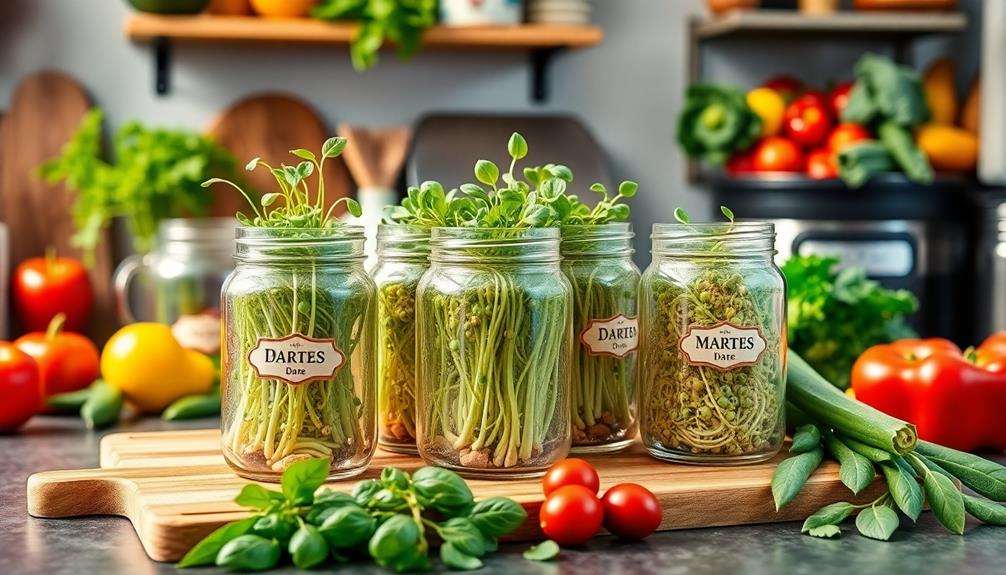To safely sprout seeds, start by soaking them in clean, filtered water for 12-24 hours based on their size. Rinse your seeds 3-4 times a day to keep them moist and promote healthy growth. Always sanitize your seeds and sprouting equipment to prevent foodborne illnesses. Maintain good air circulation during the sprouting process and store your sprouts in airtight containers in the fridge. Remember to monitor for spoilage and consume them within a week. Following these safety precautions will maximize the benefits of sprouts in your diet. Discover more techniques and tips to enhance your sprouting experience!
Key Takeaways
- Soak seeds in clean, filtered water for 12-24 hours to initiate germination and enhance safety.
- Rinse seeds 3-4 times daily to maintain moisture and prevent harmful bacteria growth.
- Sanitize seeds before sprouting using a hydrogen peroxide solution to reduce foodborne illness risks.
- Store sprouts in airtight containers and consume within a week for optimal freshness and safety.
- Monitor growing conditions, keeping sprouts in a well-ventilated area at ideal temperatures (60°F to 75°F) to prevent spoilage.
Understanding Sprouting Basics

When it comes to sprouting, many people find it easier than they expected. The process starts with soaking seeds in water for 12-24 hours, allowing them to absorb moisture and begin germination. Mung beans are a popular choice due to their impressive nutritional benefits, including increased vitamins and protein.
After soaking, you'll drain the seeds and rinse them 3-4 times daily, which keeps them moist and promotes healthy growth. You can sprout almost any seed, grain, or legume at home using simple tools like a wide-mouth mason jar and breathable fabric.
The key is to guarantee proper sanitation of both the seeds and your sprouting equipment. This step is vital, as it helps prevent foodborne illness, making sure the sprouts you enjoy are safe to eat.
As sprouts develop, you'll notice they become rich in enzymes, enhancing digestibility and overall nutritional value compared to their unsprouted forms. By understanding these basics of sprouting, you can confidently begin your journey to enjoy fresh, nutritious sprouts right from your kitchen!
Advantages of Sprouting

Sprouting is a nutritional powerhouse that boosts vitamins and fiber, making it a great choice for your diet.
In addition, sprouted grains can enhance the nutrient retention in your meals, similar to the benefits of a raw food diet, which emphasizes unprocessed, uncooked foods.
Plus, you can easily grow sprouts at home with just a mason jar and clean water, so you'll always have fresh ingredients on hand.
Their crunchy texture and versatile flavor can elevate any dish, giving you a healthy alternative to processed foods.
Nutritional Powerhouse
Discover the remarkable benefits of incorporating sprouts into your diet, as they serve as a concentrated source of essential vitamins and nutrients. Sprouts, especially when grown from organic seeds, often contain higher levels of vitamin C and B vitamins than their unsprouted counterparts. This means you're getting more nutrients packed into every bite.
Additionally, incorporating foods like apple cider vinegar can further enhance your digestion and nutrient absorption.
Not only do sprouts enhance your nutrient intake, but they also provide pre-digested proteins and natural sugars that boost your energy levels and overall vigor. This is particularly true for broccoli sprouts, which are rich in sulforaphane—a compound linked to cancer-reducing properties.
The sprouting process considerably improves digestibility by breaking down anti-nutrients found in grains and legumes. This means your body can absorb more nutrients efficiently, helping you feel your best.
Incorporating sprouts into your meals offers a low-calorie, nutrient-dense food option that can replace processed foods, making it easier to maintain a healthier diet.
Easy Home Cultivation
Growing your own sprouts at home isn't only simple but also a rewarding way to guarantee you have fresh, nutritious food at your fingertips. The sprouting process enhances the nutritional value of seeds, boosting essential vitamins, minerals, and dietary fiber while improving digestibility.
Sprouts are particularly beneficial as they contain higher enzyme content, which may aid in digestion and nutrient absorption making raw nutrition bars. Plus, it's easy to grow sprouts without any special equipment or a sunny window—perfect for your apartment or small space.
All you need is a mason jar, clean water, and your choice of seeds, whether they're legumes, grains, or herbs. The beauty of home sprouting lies in its versatility; you can experiment with various seeds to enjoy diverse flavors and health benefits. Fresh sprouts add a delightful crunch and serve as a healthy alternative to processed options.
While it's essential to follow proper hygiene practices to minimize the risk of harmful bacteria, the ease and cost-effectiveness of sprouting make it an accessible option for everyone.
In just a few days, you'll have a fresh supply of sprouts ready to elevate your meals, making it a fun and fulfilling way to cultivate your own nutritious food right at home.
Culinary Versatility
Elevate your meals with the culinary versatility of sprouts, which add a delightful crunch and vibrant flavor to a wide range of dishes.
Whether you're tossing them into salads, layering them in sandwiches, or incorporating them into stir-fries, edible sprouts are a fantastic ingredient for various culinary applications.
Sprouting seeds like lentils and chickpeas not only enhance your dishes but also offer high protein content, making them excellent meat substitutes in vegetarian and vegan meals.
This nutrient-dense addition boosts the overall health benefits of your meals.
Moreover, sprouting increases the bioavailability of essential vitamins and minerals, such as vitamin C and B vitamins, ensuring you get the most out of your food.
The natural enzymes in sprouts also aid digestion, making it easier to enjoy these raw ingredients without the discomfort often associated with raw grains and legumes.
Feel free to mix different types of sprouts—like alfalfa, broccoli, and radish—to create unique flavor profiles and add visual appeal to your dishes.
This encourages creative culinary experimentation, allowing you to explore the endless possibilities that sprouts offer in your cooking.
Step-by-Step Sprouting Process

To successfully sprout seeds, you'll need to start by soaking them in clean, filtered water for 12 to 24 hours, depending on the type of seeds you're using. After soaking, drain the water and rinse the seeds thoroughly. Place them in a jar or sprouter that allows for good air circulation and drainage. Remember to rinse and drain your sprouts 3-4 times daily to keep them moist but not soggy.
| Tip | Benefit |
|---|---|
| Keep rinsing regularly | Prevents mold growth |
| Good air circulation | Promotes healthy growth |
| Store in the fridge | Maintains freshness |
Maintain the sprouting jar in a well-ventilated area away from direct sunlight. This helps with growing sprouts efficiently. Once the sprouts reach the desired length (usually a few days), perform a final rinse. Drain your sprouts well, then store them in an airtight container in the refrigerator. Consume them within a week for peak freshness. Following these steps guarantees you get the most from your sprouting experience, making it enjoyable and rewarding!
Essential Resources for Sprouting

When you're diving into the world of sprouting, having the right resources at your fingertips can make all the difference.
Start with informative books like *How Can I Grow and Use Sprouts as Living Food* or *The Sprout Book*. These guides not only explain how to sprout but also highlight the benefits of using high-quality organic seeds.
You can find popular sprouting beans such as alfalfa, mung beans, and lentils from retailers like Sproutman.com, TrueLeaf Market, or even Amazon for easy access.
Online platforms are also invaluable. Join Facebook groups or check out YouTube channels for community support and visual tutorials that can help you navigate the sprouting process.
You'll learn how to optimize your germination rate and guarantee your sprouts grow strong and healthy.
Community and Lifestyle Benefits

Sprouting offers a myriad of community and lifestyle benefits that can enhance your overall well-being. By growing your own sprouts, you're not just cultivating nutritious food; you're also integrating a healthy practice into your living space, perfect for apartment dwellers. This hands-on approach fosters a deeper connection to plant-based eating, allowing you to truly appreciate the nutritional benefits of fresh, raw foods.
Engaging in home sprouting can also connect you to a vibrant community. Online social media groups are filled with fellow enthusiasts keen to share tips, recipes, and encouragement. This support can be invaluable, especially if you're considering shifting to a vegan lifestyle. Mentorship from experienced members often paves the way for sustainable dietary changes.
Additionally, sprouting can be a fun and educational family activity. It fosters togetherness and teaches children about food sources and nutrition, creating lasting lessons in health and sustainability.
Safety Precautions for Sprouting

When it comes to sprouting, proper seed sanitization is essential to prevent contamination.
You should always soak your seeds in a sanitizing solution before starting the sprouting process.
Additionally, keeping an eye on the growing conditions will help guarantee your sprouts remain safe and healthy.
Proper Seed Sanitization
Guaranteeing your seeds are properly sanitized is essential for a safe and successful sprouting experience. The U.S. FDA recommends soaking seeds to reduce the risk of foodborne illnesses. When you soak seeds, be mindful of the time; excessive soaking can hinder germination rates, while insufficient soaking mightn't effectively eliminate harmful contaminants.
For proper sanitization, consider using disinfecting agents like hydrogen peroxide or calcium hypochlorite. While vinegar is a common choice, it can damage vulnerable seeds, such as broccoli, so it's better to opt for gentler methods.
In addition to sanitizing seeds, make certain all your equipment—like jars and lids—is thoroughly cleaned and sanitized before use. This practice helps prevent cross-contamination and guarantees a safe environment for home sprouters.
Monitor Growing Conditions
Creating a safe environment for your sprouts is essential for their healthy growth. Here are three key factors to take into account:
- Ventilation: Make sure your sprouting area is well-ventilated. Stagnant air can promote harmful bacteria, so avoid direct sunlight to prevent overheating.
- Water Management: Rinse and drain your sprouts 3-4 times daily. This keeps them moist but not waterlogged, which helps prevent rot and bacterial contamination. Always use clean, filtered, or distilled water for soaking and rinsing.
- Temperature Control: Monitor the temperature of your sprouting area closely. Keep it between 60°F and 75°F (15°C to 24°C) for ideal growth conditions.
If you notice any foul odors, slimy textures, or signs of spoilage, don't hesitate to discard those sprouts. These signs indicate potential bacterial growth that could compromise your safety.
Disinfecting Sprouting Seeds

Disinfecting sprouting seeds is essential for preventing contamination from harmful bacteria like E. coli and salmonella. The U.S. FDA recommends soaking and sanitizing your seeds to minimize health risks associated with home sprouting. You can use common disinfecting agents like vinegar, hydrogen peroxide, or calcium hypochlorite to clean your seeds effectively.
When soaking seeds, remember that the duration varies by type. Small seeds typically require about 4 hours, while larger seeds should soak for 8 to 10 hours. However, avoid excessive soaking, as it can negatively impact germination rates.
Be cautious when disinfecting broccoli seeds with vinegar, as it may damage them; consider alternative sanitization methods to maintain seed viability.
Implementing proper sanitation practices is just as important. Always clean your equipment thoroughly and use filtered water to reduce the risk of contamination.
Proper Storage Techniques

To keep your sprouts fresh and safe for consumption, proper storage techniques are essential. Follow these tips to maintain their quality and prevent spoilage:
- Rinse and Drain: Always thoroughly rinse your sprouts before storage to eliminate any residual bacteria. After rinsing, make sure to thoroughly drain them to avoid excess moisture.
- Use an Airtight Container: Store your fully sprouted seeds in an airtight container to maintain freshness. This helps prevent contamination and keeps your sprouts crisp in the refrigerator.
- Monitor for Spoilage: Check your sprouts regularly. Consume sprouts within a few days for ideal flavor and nutrition. Discard any that emit foul odors or show signs of spoilage, as these can indicate mold growth.
Line your storage container with a clean tea towel to absorb excess moisture, which further reduces the risk of mold growth.
Keep your sprouts in a cool, dark, and dry location within the refrigerator to extend their shelf life. By following these proper storage techniques, you can enjoy safe and delicious sprouts for your meals!
Frequently Asked Questions
Can I Sprout Seeds From My Kitchen Pantry?
You can sprout seeds from your kitchen pantry, but make certain they're suitable for sprouting. Rinse them well, provide moisture, and watch for growth. It's an easy, rewarding way to enhance your meals with fresh nutrients.
How Long Do Different Sprouts Take to Grow?
Growing sprouts is like watching a garden awaken. Depending on the type, sprouts usually take anywhere from 3 to 14 days. Just water them regularly, and you'll see your kitchen transform into a mini farm!
Can Sprouts Be Grown Without Sunlight?
Yes, you can grow sprouts without sunlight. They thrive in dark, moist environments. Just keep them in a jar, rinse regularly, and within a few days, you'll have fresh, delicious sprouts ready to enjoy!
Are There Any Non-Seed Options for Sprouting?
You might think sprouts only come from seeds, but you can also sprout grains like quinoa or legumes like lentils! These options offer unique flavors and nutrients, expanding your sprouting adventure beyond traditional seeds.
What Are the Best Types of Seeds for Beginners?
For beginners, alfalfa, mung bean, and broccoli seeds are fantastic choices. They sprout quickly and require minimal care, making them perfect for your first sprouting experience. You'll love the fresh flavors they add to your meals!
Conclusion
So there you have it—your ticket to becoming a sprouting savant! With all the precautions you've learned, you can now grow your own mini salad factory right at home. Just remember, if your sprouts start plotting world domination, it might be time to reassess your techniques. Embrace the crunchy goodness, and may your kitchen be filled with life (and maybe a little chaos). Who knew being a raw food enthusiast could come with a side of adventure? Happy sprouting!










